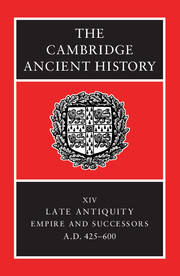Book contents
- Frontmatter
- PART I CHRONOLOGICAL OVERVIEW
- PART II GOVERNMENT AND INSTITUTIONS
- PART III EAST AND WEST: ECONOMY AND SOCIETY
- PART IV THE PROVINCES AND THE NON-ROMAN WORLD
- 18 The north-western provinces
- 19 Italy, A.D. 425–605
- 20 Vandal and Byzantine Africa
- 21a Asia Minor and Cyprus
- 21b Syria, Palestine and Mesopotamia
- 21c Egypt
- 22a The Sasanid monarchy
- 22b Armenia in the fifth and sixth century
- 22c The Arabs
- 23 The Balkans and Greece 420–602
- PART V RELIGION AND CULTURE
- Conclusion
- Chronological Table
- BIBLIOGRAPHY
- Index
- References
22b - Armenia in the fifth and sixth century
from PART IV - THE PROVINCES AND THE NON-ROMAN WORLD
Published online by Cambridge University Press: 28 March 2008
- Frontmatter
- PART I CHRONOLOGICAL OVERVIEW
- PART II GOVERNMENT AND INSTITUTIONS
- PART III EAST AND WEST: ECONOMY AND SOCIETY
- PART IV THE PROVINCES AND THE NON-ROMAN WORLD
- 18 The north-western provinces
- 19 Italy, A.D. 425–605
- 20 Vandal and Byzantine Africa
- 21a Asia Minor and Cyprus
- 21b Syria, Palestine and Mesopotamia
- 21c Egypt
- 22a The Sasanid monarchy
- 22b Armenia in the fifth and sixth century
- 22c The Arabs
- 23 The Balkans and Greece 420–602
- PART V RELIGION AND CULTURE
- Conclusion
- Chronological Table
- BIBLIOGRAPHY
- Index
- References
Summary
‘Armenia’ has always had an ambiguous place between the major powers, be they the east Roman empire and Sasanian Iran, the Byzantine empire and the caliphate, or the Ottoman empire and the Safavids. Armenian loyalties have not been consistent, either in support of a coherent internal policy or with regard to external diplomacy. The very definition of ‘Armenia’ highlights the problem. Does the term refer to a geographical entity – and if so, what are its borders? Or does it refer to a people with common bonds – and if so, are those bonds linguistic, religious, cultural or political?
Despite the conversion of king Tiridates to Christianity, probably in 314, and the establishment of an organized church, the continuing strength of Iranian traditions and the cultural and kinship ties of the Armenian nobility to Iran made Armenia an uncertain ally for the Romans. Yet since the Armenian monarchy was a branch of the Arsacid dynasty which had been overthrown by the Sasanians in 224, relations between Armenia and Iran were already strained. Tiridates’ conversion compounded an already difficult situation, for the shahs naturally became suspicious of the future loyalty of Armenians to their Iranian heritage. In the fifth century, attempts by the shahs to impose Zoroastrianism led to armed conflict – while to the west, the Armenians found their relationship with fellow Christians increasingly marred by their involvement in the struggles over orthodoxy. The division of Armenia c. 387 into two monarchies and two spheres of influence – a large Iranian sector east of the forty-first parallel of longitude, and a much smaller Roman sector west of that line up to the Euphrates – did not solve ‘the Armenian question’.
- Type
- Chapter
- Information
- The Cambridge Ancient History , pp. 662 - 677Publisher: Cambridge University PressPrint publication year: 2001
References
- 1
- Cited by



